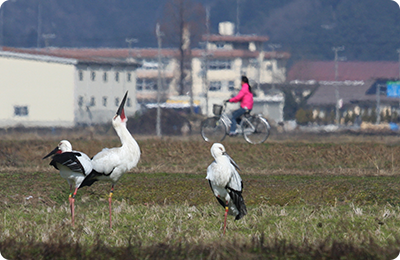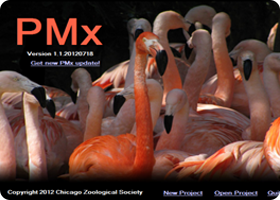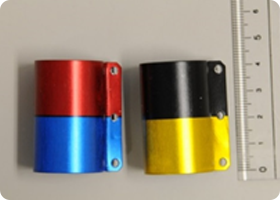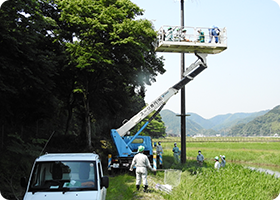Activity of each working groupActivity contents
Activity of each working group


What is the ex situ conservation?
Ex situ population acts as the source for the release and insurance against accidental events that can occur in the in situ population. To maintain the ex situ population in a sustainable state, as many individuals as possible must be kept and as much genetic diversity as possible should be maintained.
Members of the ex situ conservation working group and its activity
Here, we consider individual storks reared in different facilities across Japan as a single population to formulate population management plans and support the participating organizations and facilities to cooperate in implementing these plans. We also engage in developing captive breeding techniques and public relation activities.
Activity content
Introducing the main activities of the ex situ conservation working group1. Formulating the management plans to maintain the population and genetic diversity of the ex situ population and support the implementation of these plans.
Based on this plan, we strive to maintain an appropriate population by pairing and conducting reproductive management taking the genetic diversity into account. Breeding control includes the movement of fertilized eggs between facilities, aiming at the reduction of stress on the birds.
2.Improvement of techniques, necessary for captive management and veterinary treatment
We promote the sharing of oriental white stork medical data.
3. Research on the management of ex situ populations and presentation of the results
We hold lectures for the general public that contributes to public awareness about oriental white stork conservation conducted by IPPM-OWS through presentation of our initiatives and research results.
4. Promotion of public awareness activities


What is the in situ conservation?
Since oriental white storks in Japan went extinct in 1971, in situ conservation has been initiated by reintroducing captive-bred individuals into their original habitats.
In 2007, breeding in the wild started and the in situ population has been increasing steadily.
However, various problems are emerging. For instance, there are insufficient water linkage required to increase prey biomass and availability; there is an imbalance between stork families that succeed in fledging young in the wild; and the risk of kinship mating is increasing.
The members of the in situ conservation working group and its activity
Activity content
Introducing the main activities of the in situ conservation working group1.In situ population management based on scientific knowledge
2.Support for local stakeholders and institutions working on reintroduction
3.Promotion of public awareness activities
4.Providing information on wild storks
5.Improvement of various techniques related to reintroduction
Examples of activities
Formulation and implementation of management plans for in situ and ex situ populations
We also advise each member organization and facility in order that technical supports can be provided appropriately between them.

Demographic software PMx
IPPM-OWS utilizes PMx, a demographic software for population management.
Based on information on the family lineage following the founder (the first generation that entered captivity and bred), individual information, such as sex and birth date, can be used for demographic analysis. Further, based on breeding success rate, breeding period and genetic interrelationships of the entire population, future predictions on effects of new-born chicks on the overall genetic diversity of the population are made possible.
Transport of fertilized eggs
IPPM-OWS formulates population management plans based on scientific evidences and promotes gene exchange by transporting oriental white storks across the member facilities.
The exchange between member facilities by transporting fertilized eggs is increasing. This is due to the fact that the risk of accidents and the cost of egg transfer are lower than that of bird transfer.
Oriental white storks generally continue to incubate their eggs and raise hatchlings even when the eggs are exchanged during incubation period. Therefore, just the same results as transporting individual birds are available by replacing the fertilized eggs brought from another facility.
 Transportation by railway
Transportation by railway
When transporting, fertilized eggs at the late stage of development are placed in a portable egg incubator (small egg incubator for transportation) and transported using railways.
Because developing fertilized eggs may stop growing due to shaking and vibrating, during transportation, the incubator is placed on the lap and carefully handled to avoid shaking or vibration as much as possible.
Identification of individuals in the wild
 Leg bands that wild oriental white storks are put
Leg bands that wild oriental white storks are put
Leg bands (colored ones) are attachd to released birds and fledgelings in the wild for individual identification.
The color pattern of the leg band is unique to each individual bird. This makes it possible to obtain basic information about the wild storks, such as home range and their status in pair formation, which is useful for grasping the progress of our reintroduction projects. The state of affairs that almost all of the birds are individually identifiable is rare for reintroduced populations in the world.
IPPM-OWS provides leg bands to local governments that have stork nestlings to be banded in the wild and rents an operation vehicle indispensable for banding at a height over 10m, as needed.
Implementation of training
 Training for capturing nestlings
Training for capturing nestlings
IPPM-OWS conducts training in various occasions to improve the skill of all member of the organizations concerned.
The training menu conducted until now includes those on captive breeding (e.g. handling of egg incubator), on capturing individual birds, and on putting leg bands on wild storks.
